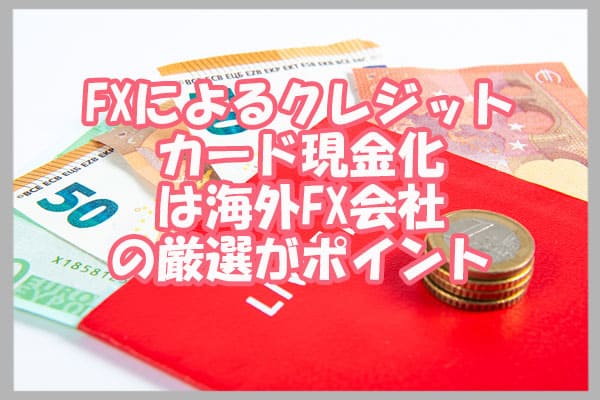資産運用の1つとしてレバレッジ取引が出来るFXは、利益が出た時点で課税対象となるので早めに現金化したいと考える人が多いです。ハイリスク・ハイリターンを特徴とするFXには、クレジットカード現金化に対応した取引方法が存在します。では、FXを使って現金化するためには、どのような点を知っておかなければならないのでしょうか。
FXを現金化するなら海外のFX?日本国内のFX会社では意味が変わる

FXは外国為替証拠金取引と呼ばれる投資目的で行う為替取引を指します。レバレッジ取引を証拠金を納めることで好みの倍率設定を行って、手持ちの資金以上のハイリスク・ハイリターンな取引が可能です。1,000通貨単位から始められるので、低倍率であっても10万円以上の資金があれば比較的スムーズにFX取引を始められます。FXで取引を行い最終的に出金処理を行うことも現金化と呼ばれますが、FXを使った現金化は主にクレジットカード現金化の手法として捉えられることが多いです。
日本国内のFX会社は入金方法が銀行振込
日本国内のFX会社は、金融庁の管理下で全ての取引履歴を金融庁へ提出する義務を負っているので、最初から銀行振込によるFX取引口座への入金方法しか用意されていません。このため、クレジットカード決済により手持ちの資金が無くてもFX取引による現金化を行いたいなら、必然的に海外のFX会社を利用しなければならないわけです。
海外のFX会社なら入金方法が多彩な所が多い
海外のFX会社ならば、FX取引口座への入金方法は複数用意されています。
・銀行振込
・paypalといった電子決済サービス
・クレジットカード
・デビットカード
・小切手
FX会社ごとに受け入れ可能な方法は異なるものの、日本国内のFX会社とは異なりクレジットカード決済による入金が可能となっています。この際に注意しなければならないポイントとして、現地通貨建ての決済となる点が挙げられます。日本円建ての決済では無いために、後から現金化しようとしてショッピング決済がキャンセルとなった場合には、戻り額が為替相場の影響を受けてしまう点に注意しなければなりません。
クレジットカード経由で海外のFX会社へ入金すれば現金化出来る
クレジットカード経由で海外のFX会社へ口座開設の上で証拠金を入金すれば、FX取引が可能です。しかし、海外のFX会社へクレジットカード決済経由で入金する際には、口座開設時に提出した身分証明書を再度提示するように求められることがあります。現地通貨建ての入金となるために、最初の段階で為替相場の影響を受ける仕組みです。本人確認を厳格に行うことにより、後日カード会社からの問い合わせがあっても速やかに対応出来るようにしています。
海外FX会社経由でのクレジットカード現金化はシステムに注意しよう

海外FX会社経由でのクレジットカード現金化は、日本国内でクレジットカード現金化業者を使った時の決済システムとは異なる点に注意が必要です。ショッピング枠を使って海外FX会社の取引口座への入金を行うことになりますが、商品を購入したわけではなく決済を行っただけに過ぎません。では、どのような点が現金化を行う際に問題となるのでしょうか。
海外FX会社の出金がカード決済キャンセルになる理由
海外FX会社へクレジットカード経由で証拠金を入金し、FX取引を行った結果として利益が出た場合には、現金化を行うために出金手続きを行うことになります。しかし、海外FX会社からの出金処理は元々クレジットカード決済による入金のために、多くの海外FX会社ではカード決済キャンセル手続きとなる点に注意しなければなりません。分かりやすい例で説明すると、AさんがB社発行クレジットカードにて海外FX会社C社へ10万円を入金してFX取引を行い、運良く5万円の利益が得られた場合を考えるとイメージが湧きます。AさんがFX口座から出金手続きを行うと、口座に残っていた15万円のうち10万円がB社に戻されて、5万円をAさんの銀行口座へ振込する形です。
①Aさん→B社クレジットカードを10万円ショッピング利用
②C社が出金処理のためにB社クレジットカード10万円利用分をキャンセル手続きし、残り5万円をAさんへ銀行振込する
③B社の利用可能額が為替相場により10万円前後の利用可能額としてキャンセルにより戻る
という一連の流れとなります。
実際には取引手数料や口座維持手数料に加えて海外口座からの国際振込送金手数料が必要です。しかし、15万円がAさんの預金口座へ振り込まれるわけではなく、あくまでも利益が出た分についてのみしか預金口座へ振り込まれないので、運用に失敗すれば現金化出来ないことになります。
もし、すぐにでも現金が必要でfx現金化したいと考えている方は、他の方法がいいです。
最近では、いろんな現金化方法があり、ビットキャッシュ買取やAppleギフトカード買取、後払いアプリを利用した現金化などもあります。
状況に応じて使い分けることで損をすることもなくなるので、今fx現金化が必要なのかもう一度冷静になって考えてみてください。
利益が出た分しか現金化出来ないジレンマ
海外FX会社ならばクレジットカード決済による入金が出来るから現金化しやすいという考えをしていると、出勤時にクレジットカードの利用可能額が戻るだけという状況となりかねません。最初からクレジットカード現金化のために海外FX口座を利用しようと考えているならば、FX会社の選び方をしっかり覚えないと資産運用しない限りすぐに現金化出来ないことが分かります。また、クレジットカードのキャンセル手続きを海外FX会社が行った際には、手元に現金が戻るわけではなく与信枠が戻るだけという状態にも関わらず、締め日以降にキャンセル手続きが入ると請求だけは先に届いてしまうわけです。カード会社と海外FX会社の取引状況次第では、与信枠が戻るまでに数ヶ月要することも珍しくありません。
クレジットカード経由での入金を全額現金化出来る海外FX会社を使えば良い
実は最もシンプルな海外FX会社を利用したクレジットカード現金化は、クレジットカード経由での取引口座入金分がキャンセル扱いとならない海外FX会社を利用すれば良いわけです。上記例であれば、15万円全額をAさんが指定した口座へ振込依頼すればクレジットカードショッピング枠は単に使っただけという扱いとなり、手元に国際振込送金手数料を差し引いた金額が現金化されて振り込まれます。
BigBossとIFCMarketsの2社は、クレジットカード入金した金額とFX取引により利益の合計額を指定の銀行出金出来る貴重な海外FX会社です。入出金手数料が必要となる点は注意しなければなりませんが、クレジットカード決済による入金を行い、数回トレードした程度で出金処理を行えば10,000通貨単位の取引を行ったとしてもレバレッジを下げれば損失は誤差の範囲で済みます。
FXで現金化したら税金の支払いを忘れてはならない

FXによりクレジットカード現金化を行った場合には、税金の支払いを忘れてはなりません。資産運用を行った形になるので、運用益に対しては税率は2037年12月31日まで20.315%の割合で課税されます。所得税15%+復興特別所得税0.315%+住民税5%の合計により20.315%となりますが、経費や各種控除の適用を受けた上で最終的な利益に対して課税される仕組みです。
FXにより得た利益は課税対象
FX取引は高いレバレッジ設定を行うことで、為替相場が比較的安定している局面であっても利益を挙げることが可能です。日本国内のFX会社では最大レバレッジ設定が25倍となっていますが、海外FX会社の中には50倍以上の設定を可能としている所が少なくありません。証拠金取引で大幅な損失を出してしまうと、追証と呼ばれる追加の入金を求められることがあるので、FXにより得た利益が一気に吹き飛んでしまうことが有り得ます。FXにより得た利益は、元旦から大晦日までの期間で計算されて、最終的な年間取引収支報告書を作成して確定申告を行わなければなりません。株取引とは異なり海外FX会社で行った取引に関しては、残念ながら自分で年間取引収支報告書の作成をしなければならないので、必要な英語力を鍛えておかなければ苦労することになります。クレジットカード現金化のために海外FX会社を使うとしても、流石にショッピング利用日と出金申請日を同一にすることはカード会社からの問い合わせ発生時に海外FX会社による回答の影響でクレジットカードが利用停止となるリスクを避けられません。そこで、少なくともクレジットカード経由での入金から出金までを1週間以上開けた上で、FX取引を数回行うといった現実の取引を実施しておくことが望ましいです。
赤字の確定申告なら3年間損失を繰り越して税金を節約出来る
海外FXを利用したクレジットカード現金化では、利益を出してしまうと課税対象となるため、僅かながら損失を出した状態で年末を迎えるといった方法が望ましいです。もし仮に損失が出ていたならば、最大3年間損失を繰り越して税金を節約出来ます。海外FX口座は、日本国内の銀行口座とは異なりFX口座ならではの特徴として複数の手数料が発生する点を忘れてはなりません。少なくとも次の5種類の手数料が必要になる点を考慮して、どれだけ長い期間海外FX口座を維持するか決めると良いです。
・口座開設費用
・取引手数料
・システム手数料
・入出金手数料
・口座維持手数料
特に海外FX口座を利用してFX取引を行う予定が無い場合には、口座維持手数料が安い海外FX会社を探しておく必要があります。また、FX口座を開設したままの状態でFX取引を全く行わないと、口座が凍結されてしまうことがあるので英語力に自信が無い人は取引口座の維持管理のために手間が掛かる点を覚悟しなければなりません。
FXの取引履歴をまとめてくれるFX会社なら税金申告が楽になる
日本国内のFX会社ならば、元旦から大晦日までの年間FX取引について、損益報告書または取引計算書という形で確定申告時期が近づくと受け取れます。しかし、海外では課税申告期間が異なるので、日本向けに合わせた損益報告書の作成をしてくれるとは限りません。数回の取引のみならば自力で損益計算書を作成して確定申告を行えますが、口座維持のためにFX取引を少額だけ継続していた場合には、取引履歴をまとめてくれる海外FX会社を最初から選んでおくと良いです。この際に注意しなければならないポイントとして、日本の課税制度ではポジション保有のみでは課税対象とならない点が挙げられます。
日々のスワップポイントをポジション保有中に日々現金化される場合には、年末までに確定された分が損益報告書の対象となりますが、ポジション決済後にまとめて現金化される場合には決済しない限り所得となりません。年末が近づいた時に決済するかどうかを見極めることも、海外FX取引では税金対策として注意する必要があります。
FXによるクレジットカード現金化は海外FX会社の厳選がポイント

銀行振込によるFX取引口座への入金しか認めない日本国内FX会社とは異なり、海外FX会社を利用すれば手持ちの現金が無くてもクレジットカード決済により入金可能です。FX取引を行った後にスワップポイントを決済した結果として、必ずしも全額が振り込まれるとは限らないので、海外FX会社選びを行う際には出勤時にクレジットカード決済分がキャンセル処理される会社を避ける必要があります。
どれぐらいの収入を得たいのかをまず決めておく

副業をこれから探す際に、まずどれぐらいの収入を得たいのかを決めておくようにしましょう。
なぜなら、仕事内容や案件によって、希望通りの収入を稼げるとは限らないからです。
例えば、月に1万円程度でいいのであれば、アンケートモニターやポイントサイトをフル活用すれば、手の届く金額になるでしょう。
一方で、月に3万や5万円も稼ぎたいのであれば、さすがにそれだけでは困難だと言えます。
月に3万から5万円ほど稼ぐのであれば、Webライターの仕事をしたり、ブログを運営して広告収入を得るなど、それぐらいの取り組みが必要になってきます。
さらに、月に10万円ぐらい稼ぎたいのであれば、より専門的な仕事を行う必要があるでしょう。
システム開発やプログラミングといった、かなりのスキルを要する案件をこなすことが求められます。
このように、稼ぎたい金額によって、どの仕事に取り組むのがいいかは違ってきますし、金額によっては物理的な不可能なケースもあるのです。
副業に費やせる時間は限らているわけですし、自分のスキルや知識とも相談をしながら、目標金額を決めて副業を選ぶようにしましょう。
とりあえず、初心者ならたとえ目標の金額には届かなかったとしても、比較的難易度の低い仕事から始めていくのがいいでしょう。
スキルとレベルを高めていけば、より報酬の高い仕事もできるようになるでしょうから、焦る必要は全くないのです。
もちろん、今後副業の仕事で独立や起業を考えたり、将来的には本業にしたいと考えているのであれば、現状で満足せずに常に上を目指していくことが求められるでしょう。

